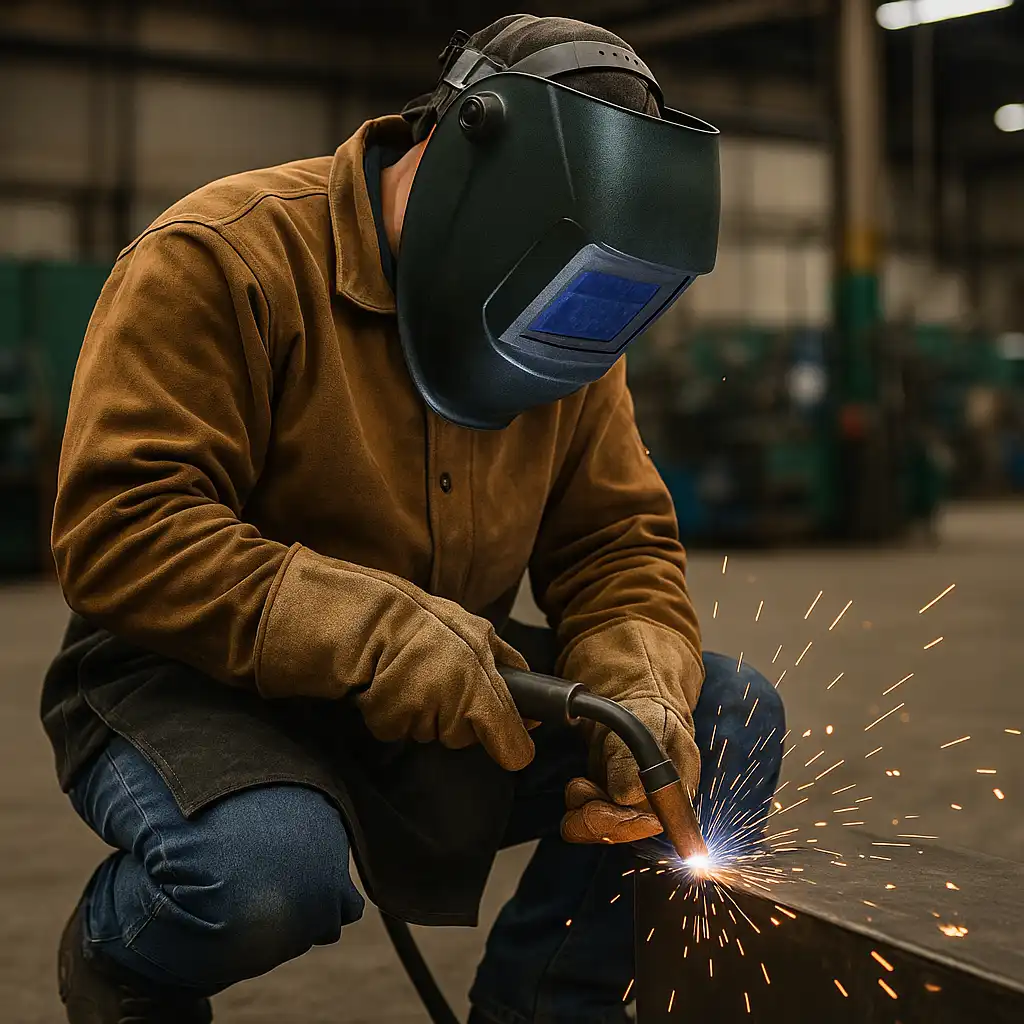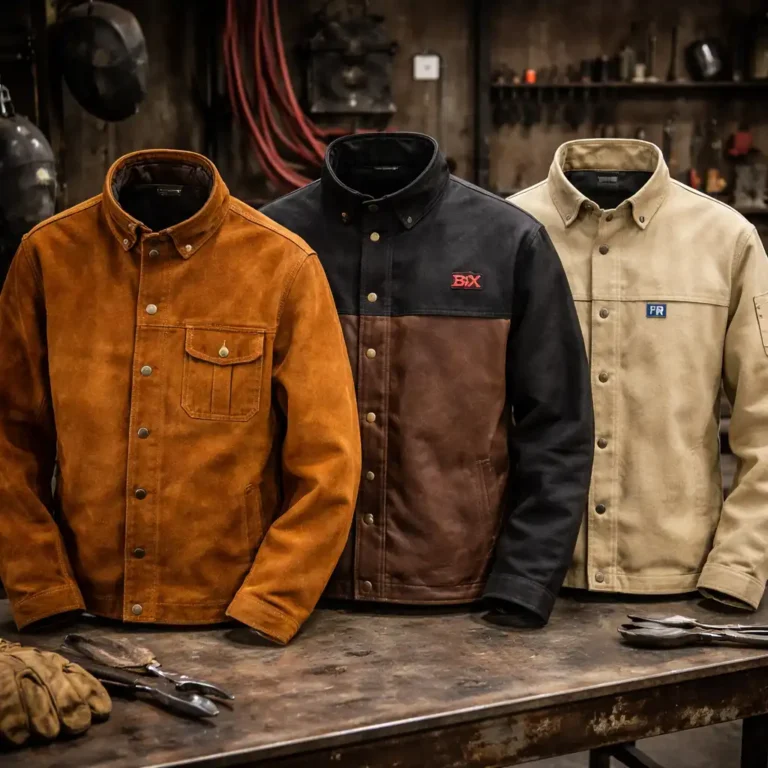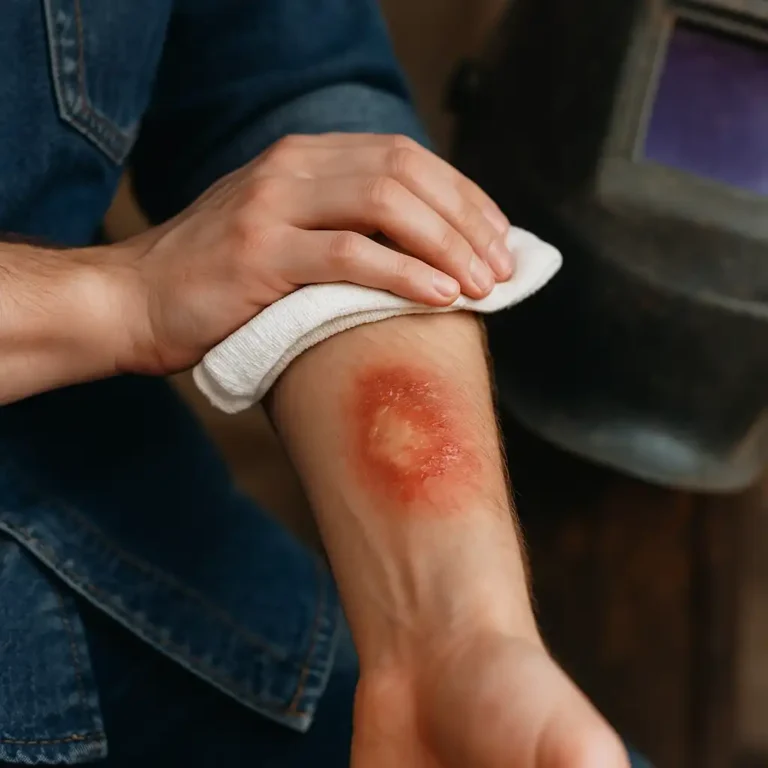Safety Equipment in Welding Workshop: What Every Welder Should Use

Disclosure: This post contains affiliate links. As an Amazon Associate, I earn from qualifying purchases—at no extra cost to you.
Last Updated: December 2025
When you’re working in a welding workshop, the right safety gear isn’t optional—it’s part of the job. Sparks don’t behave politely. They bounce off your sleeves, roll down your pant legs, and find every opening they can. The gear you choose decides whether those sparks burn out harmlessly or turn into something painful.
Once you’ve spent some time under the hood, you start recognizing the patterns. You feel where heat builds up, which fabrics can handle real shop work, and what gear keeps you focused instead of flinching every time a spark pops off the plate.
👉 If you want a deeper breakdown of shop PPE, check out our guide to essential welding safety gear and PPE.
🔍 Why Welding Safety Equipment Matters
Every process in the welding workshop throws something at you—UV flash, spatter, slag, fumes, or straight heat. Even a quick tack weld gives off more than most beginners expect. With the right PPE, you build a reliable buffer between yourself and whatever’s happening at the workpiece.
You’re protecting yourself from:
• UV and IR radiation
• Slag and flying spatter
• Hot metal and radiant heat
• Grinding debris
• Metal fumes and dust
When your safety equipment works as it should, you can lean in, brace your hand, and focus on running a clean bead.
🔍 Core Categories of Welding Safety Equipment
Good PPE covers a few main areas. Ignore one of them, and the workshop usually reminds you why it mattered.
1. Eye and Face Protection
Your helmet is the most important piece of equipment you’ll own. A good auto-darkening hood protects your eyes from flash and reacts fast the moment the arc hits. True-color lenses make it easier to see your joint, and solid sensors keep your shade consistent even when you’re tucked into a weird angle.
For grinding, safety glasses or a face shield aren’t optional. Grinding sparks go wherever they want, and they don’t wait for you to drop your hood.
2. Protective Clothing and Gloves
Your clothing acts like a rolling shield. It needs to resist heat, avoid melting, and help sparks slide off instead of catching.
Best choices:
• FR cotton for everyday shop work
• Leather for overhead or high-spatter welding
• Wool for natural flame resistance in colder conditions
Avoid synthetics completely. Nylon, polyester, and stretch blends melt instantly and turn a tiny spark into a serious injury.
Your gloves should match the job:
• Thick leather for Stick
• Heat-padded gloves for MIG
• Thin, flexible gloves for TIG control
3. Respiratory Protection
Fumes are an easy hazard to underestimate. Different metals produce different fumes, and some hit hard even after short exposure.
Reliable options include:
• P100 disposable masks
• Half-mask respirators with P100 cartridges
• PAPR systems for heavy fume environments
Galvanized steel, stainless, and painted or coated surfaces always require filtration.
4. Foot Protection
Boots take a beating all day. Leather can brush off sparks, but mesh or rubber melts instantly, giving sparks a direct path to your foot.
Look for boots with:
• Full-leather uppers
• Slip-resistant soles
• Optional metatarsal guards
• No mesh or fabric panels
If sparks get inside your boot, your day is over fast.
5. Hearing Protection
Grinding, gouging, and air tools push workshop noise levels higher than most people realize. Earplugs or earmuffs protect your hearing and help keep the workspace comfortable during long shifts.
🔍 Safe vs. Unsafe Materials for Welding Clothing
Material choice can be the difference between a harmless pop and a real burn.
Safe materials:
• FR cotton that self-extinguishes
• Leather for heavy-duty protection
• Wool for natural flame resistance
Unsafe materials:
• Polyester
• Nylon
• Spandex blends
• Any lightweight athletic wear
If a fabric melts, it has no place in a welding workshop.
🔍 Everyday Clothing Items Welders Should Use
A reliable setup doesn’t need to be fancy—just consistent.
Shirts: Long-sleeve FR cotton or heavyweight cotton.
Jackets: FR cotton for daily use; leather or hybrid jackets for Stick and overhead work.
Pants: Heavy denim or FR cotton. Never tuck pant legs into boots.
Aprons: Leather aprons add strong front protection when you’re leaning over plate or running long welds.
Sleeves: Popular with TIG welders who want arm protection without a full jacket.
Boots: Leather work boots that keep sparks out.
Gloves: Pick gloves based on the welding process you’re running.
🔍 Maintaining Your Welding Safety Equipment
Good PPE protects better and lasts longer when you take care of it.
FR Cotton:
Wash with mild detergents, avoid fabric softeners, and keep dryer heat low. Too much heat weakens the FR treatment.
Leather:
Brush off dust, wipe lightly when needed, and condition it before it starts cracking. Never soak or machine-wash leather—it breaks down the hide and ruins its flexibility.
Clean, flexible gear breathes better, moves better, and keeps you comfortable through long shifts.
📌 Key Takeaways
- FR cotton, leather, and wool are the safest materials for welding clothing
- Never wear synthetics—they melt instantly and cause severe burns
- Your helmet and gloves do most of the daily protection work
- Respirators matter more than most beginners realize
- Well-maintained PPE performs better and lasts longer
🟢 FAQs
Q: What’s the most important piece of welding safety equipment?
Your welding helmet. Nothing else prevents flash burns the same way.
Q: Can I weld in regular jeans?
Yes—if they’re 100% cotton with no stretch. Heavy denim handles sparks much better than synthetics.
Q: Do I need a respirator every time?
If you’re welding galvanized, stainless, or anything coated, absolutely. Those fumes require filtration.
Q: Why are synthetics unsafe in the welding workshop?
They melt instantly when hit by sparks and stick to the skin, causing severe burns.
Q: Should new welders start with leather jackets?
Not always. FR cotton is cooler, cheaper, and perfect for most beginner MIG and TIG work.
✅ Conclusion
Using the right safety equipment in the welding workshop is part of working smart. A dependable helmet, FR clothing, gloves matched to your process, leather boots, and a proper respirator keep you protected from sparks, heat, and fumes so you can focus on laying clean welds. Keep your gear in good shape, replace it when it wears out, and it’ll carry you through every project the shop throws at you.






